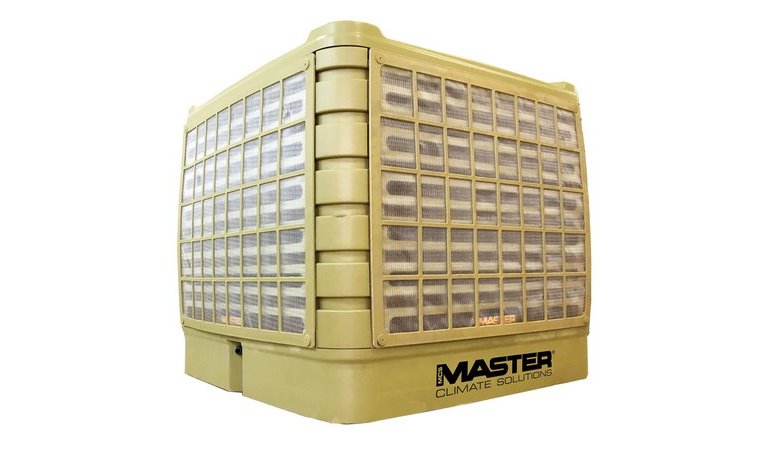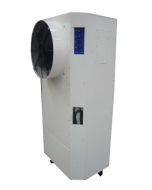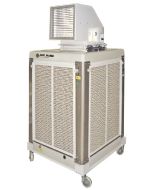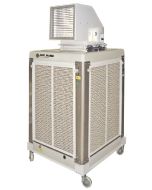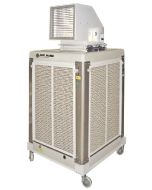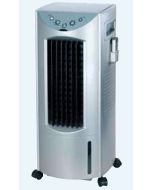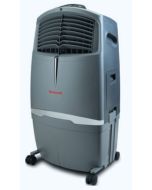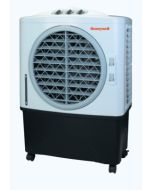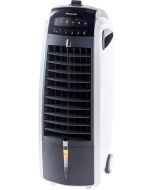This guide is aimed to cover mainly smaller mobile evaporative coolers that might be typically used in a home or office. Although we supply larger mobile units, they are more complex machines and are covered elsewhere. Here we cover mobile evaporative coolers, how they work, what size to get and top tips for selecting and maintaining a unit that meets your requirements. It's all here...
Looking to buy a mobile evaporative cooler in the UK? Click here to browse our full range from Broughton, Honeywell, Met Mann and more.
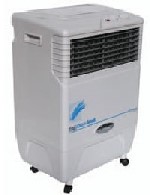
What is a Mobile evaporative cooler?
Mobile evaporative industrial coolers are the modern alternative to mobile air conditioners. Compared to air conditioning they are;
- practical
- eco-friendly
- cost-effective
- simple
In order to be comfortable in summer, you typically only need to reduce the air temperature by a few degrees to make a tangible difference between the heat of outdoors and the cool comfort of indoors and sometimes the cooling effect of air conditioning can be too much.
Mobile evaporative coolers are much simpler than air conditioners and don't need exhaust hoses routed through walls, or windows and they don't need a condenser placed outside. They are ideal for applications where using an air conditioner would be difficult (for instance where there are planning restrictions to locating condensers outside), or cost prohibitive, or where only moderate cooling is required.
How do Mobile evaporative coolers work?
In the same way that the evaporation of sweat on skin cools the skin, or where breezes coming from the sea are noticeably cool, mobile evaporative coolers work by evaporating water from a substrate material whilst blowing air through the material. The air movement through the material aids evaporation and cools as it does so. A simple and reliable mechanism within the unit ensures that the substrate material (pad) is kept damp and a prefilter keeps dust off the pad.
There are two basic families of mobile evaporative cooler mechanisms:
- Moving Wick Type
- Irrigated Wick Type
The first type which is common in many smaller domestic mobile evaporative coolers, is based on a continuous belted fabric wick that is mechanically driven through the water reservoir and across the face area of the air channel. The wet fabric wick, exposed to air passing through, evaporates some of its water content, thus cooling the air, before the belt returns to the reservoir for rewetting.
The drawback with this type of mechanism and the reason we avoid them, is poor reliability associated with the wick mechanism. Fairly typically, the small domestic units are mass-produced with poor quality plastic components in the wick drive mechanism.
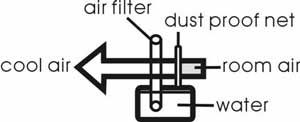
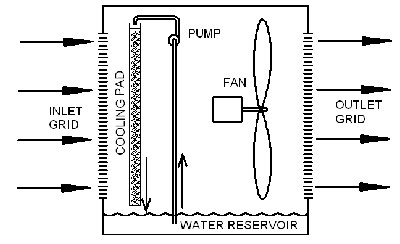
The second type is standard on virtually all industrial and commercial units and better quality domestic mobile evaporative coolers. It relies on the continuous irrigation of a cooling pad, with a pump and a recirculation pipe from the reservoir.
The water that is not evaporated on the air passing through the pad drains down by gravity back to the reservoir. The pumped system is far more reliable than any unit with a moving wick.
There are a number of different types of wick typically used in these mobile evaporative coolers, from, at the cheap end of the market, wood wool pads to the more standard cross flow block media, sometimes known as Celdek pads.
Pads are usually changeable after a period of time. The wood wool pads have a higher replacement frequency than Celdek pads.
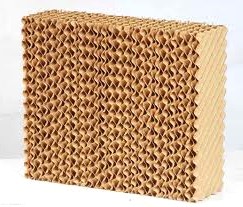
How effective are Mobile evaporative coolers?
The performance of mobile evaporative coolers depends on the ambient temperature and the percentage relative humidity (%RH). If say the ambient temperature is say 25°C, which would be a typical uncomfortable indoors temperature during summer and the relative humidity is say a typical summer level of 40% then you could expect the outlet temperature from an evaporative cooler to be between a comfortable 18 and 19°C.
It will obviously vary from one model to the next, but it is true to say that the lower the ambient relative humidity then the more they will cool. It is also the case that the greater the ambient temperature then the greater the degree of temperature drop. Mobile evaporative coolers do not have the same cooling power as air conditioning and buyers familiar with air conditioning need to adjust their expectations of accordingly. Whilst they cannot provide the harsh cooling of an air conditioner, evaporative coolers, take the 'uncomfortable edge' of the very hot days. The following table provides a reasonable guide to the cooling capacity typical of most evaporative coolers.
|
|
|
|
|
|
| %, Relative Humidity |
|
|
|
|
|
|
| ||||
| 2 | 5 | 10 | 15 | 20 | 25 | 30 | 35 | 40 | 45 | 50 | 55 | 60 | 65 | 70 | 75 | 80 | |
°C ambient |
|
|
|
|
|
|
|
|
|
|
|
|
|
|
|
|
| |
24 |
| 12 | 13 | 14 | 14 | 15 | 16 | 17 | 17 | 18 | 18 | 19 | 19 | 20 | 21 | 21 | 22 | 22 |
27 |
| 14 | 14 | 16 | 17 | 17 | 18 | 19 | 19 | 20 | 21 | 22 | 22 | 23 | 23 | 24 | 24 | 25 |
29 |
| 16 | 17 | 17 | 18 | 19 | 20 | 21 | 22 | 22 | 23 | 23 | 24 | 24 | 25 | 26 | 27 |
|
32 |
| 18 | 18 | 19 | 21 | 21 | 22 | 23 | 24 | 25 | 26 | 26 | 27 | 28 | 28 | 29 | 30 |
|
35 |
| 19 | 20 | 21 | 22 | 23 | 24 | 26 | 26 | 27 | 28 | 29 | 29 | 31 |
|
|
|
|
38 |
| 21 | 22 | 23 | 24 | 26 | 27 | 28 | 28 | 29 | 31 | 31 |
|
|
|
|
|
|
41 |
| 22 | 23 | 25 | 26 | 27 | 29 | 30 | 31 | 32 |
|
|
|
|
|
|
|
|
43 |
| 24 | 25 | 27 | 28 | 29 | 31 | 32 | 33 |
| Temperatures °C |
|
|
|
| |||
46 |
| 26 | 27 | 28 | 30 | 32 | 33 | 34 |
|
| delivered by Mobile Evaporative Coolers |
|
| |||||
49 |
| 27 | 28 | 30 | 32 | 34 | 35 |
|
|
|
|
|
|
|
|
|
|
|
52 |
| 28 | 30 | 32 | 34 | 36 |
|
|
|
|
|
|
|
|
|
|
|
|
What else affects mobile Evaporative cooler performance?
As well as the ambient temperature and the relative humidity, their performance is affected by the temperature of the water in the tank. Some units can take ice as well as water, which will enhance the performance. If the prefilter becomes blocked then this will restrict airflow and impair performance, and for this reason, units fitted with washable filters will require their filter periodically washed and those with disposable filters will require occasional filter changes.
What other effects do mobile Evaporative Coolers Have?
Because they work by evaporation they have the inevitable consequence of increasing the relative humidity in the room, so acting in the same way as a humidifier. Also, because they pass air through both a prefilter and then a damp pad, they also act as an air cleaner, and should certainly trap larger particles such as pollen; a bonus for hay fever sufferers. It is also easy to dose the water with various fragrances to add pleasant smell to the air. So long as the fragrances are not oil based and mix easily in water there should not be a problem. Some units are fitted with a heater element which means that they are a useful 'year round' appliance, rather than just a summer time cooler.
What advantages does evaporative cooling have over air conditioning?
Because they are so much simpler and use a fraction of the electricity, evaporative coolers are substantially cheaper to buy and operate compared to a similar size air conditioner. Also evaporative coolers do not rely on refrigerant gasses (CFCs) to operate and they pose no risk of leakage of these gases.
Should the doors and windows be closed when using an evaporative cooler?
No. The room that you are cooling should be open and well ventilated so far as possible, to ensure that relatively fresh air is taken through the wet pads in the machine. This reliance on fresh air makes the mobile evaporative cooler a healthier cooling system compared to air conditioning because sealed rooms such as those that are typically air-conditioned are inevitably more polluted than well ventilated rooms. To use a mobile evaporative cooler in an unventilated room increases the humidity of the air in the room and will ultimately inhibit the effectiveness of the cooler.
What should I look out for when buying an Mobile evaporative cooler?
There are two different types of mechanism for wetting the substrate material (wick) that the air is blown through. On cheaper evaporative coolers the mechanism is often that the wick is in fact continuous belt loop that is rotated through a reservoir of water and then when wet the wick moved in the portion of the machine where the air is blown through it, before returning again to the reservoir. Other models have a fixed wick which is irrigated with water by a pump that lifts water via a pipe to a percolation tray on top of the wick. Water dribbles through the wick whilst air is blown through, and excess water simply drips off back to the reservoir to be pumped again.
The latter type (i.e. those evaporative coolers with ones with pumps) are far more reliable. The point of failure on the rotating belt type is that often the gearing and motor drive that drives the belt is made of plastic which breaks. When a customer says that their evaporative cooler is not working and that there is a clicking noise from it, you can bet that the reservoir has a number of broken off teeth from the plastic drive gear in it! Generally coolers with fixed wicks and a pump based wetting system are far more reliable.
Also look for some indication on the cooler for when the reservoir is empty, and on larger industrial units look for the capability to connect water supply (rather than relying on manually filling reservoir). Many mobile evaporative coolers specifications will state what their air throw is. This is the maximum distance from the cooler that you can feel the air movement directly from the cooler. Generally the larger the air throw the better, and as you may expect, units with larger air flows have larger air throw distance.
What other considerations are there?
Mobile evaporative coolers do not have the same level of control as you would expect with an air conditioner. You cannot set a target temperature and expect the unit to reduce the temperature of the room to the target level. Their performance is dependant on their wick area, airflow, the ambient temperature and humidity. Once you set it running on a particular fan speed you get what ever cooling those parameters allow. Mobile evaporative coolers do produce quite a draft, so if you work in a feather pillow factory or an office with piles of paper on desks you may have to be a bit careful about the direction you point your cooler!
As with any machine that moves air they produce a bit of noise and indeed typically a bit more noise than air conditioning. Whilst seldom an issue in industrial environments, it is worth considering the noise before choosing to use one in an office environment.
What maintenance do Mobile evaporative coolers need?
The details of the maintenance requirements to mobile evaporative coolers will vary from model to model, however the following are points are generally true for units.
Dust invariably will become entrapped in the cooler. Where the cooler has a prefilter mesh, most of the coarse dust will become trapped there, and periodically the prefilter will need to be taken out cleaned and refitted. Finer dust will become trapped on the wick (and the coarser dust in the case of units without a prefilter) and in the reservoir water. This means that periodically the wick will need to be removed, rinsed off to remove dust and refitted.
If during this maintenance the wick is showing signs of degradation, then it may need to be replaced. Dust that is not entrapped on the wick will usually become entrapped in the water that is circulated over the wick. For this reason at the end of each season of use it is recommended that the reservoir is cleaned out and left empty and dry before storage over the colder months. Otherwise, as residual water evaporates from the cooler when not in use, the dust content will form crusts in the reservoir and when the cooler is put back into use these crusts can block pipe inlets and foul the pump mechanism.
It is also a very good idea to put in an antibacterial agent in the reservoir to keep the water biologically clean and prevent the formation of slime on the wick. For this we recommend and can supply Secosan sticks for use in all mobile evaporative coolers and humidifiers.
What size Mobile evaporative cooler do I need?
Our calculator tool will help you select the more suitable size for your evaporative cooler.
Evaporative Cooler Calculator Tool
The room size that the calculator goes up to is 75m2. If the area that please call us for help in sizing a unit to suit your application 01729 824108



